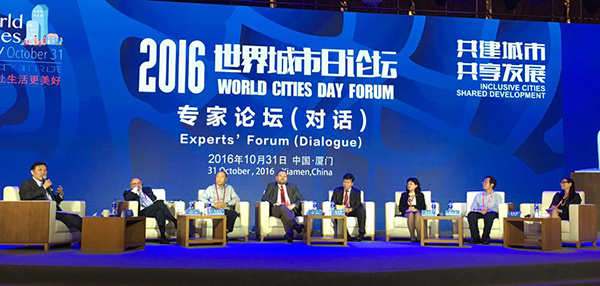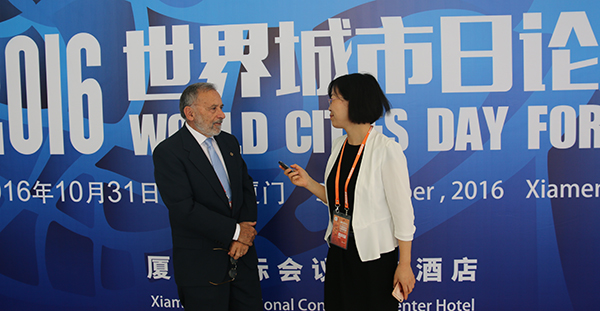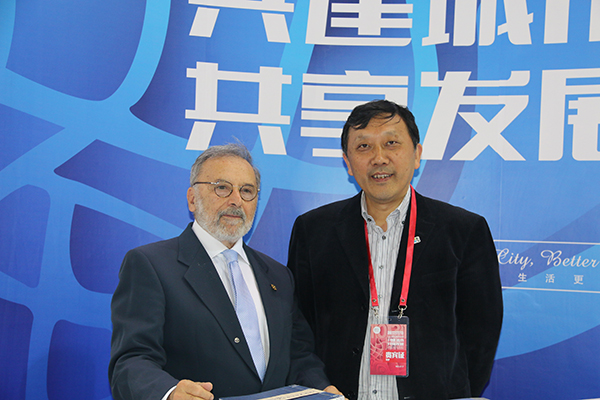


On October 31 2016, MOHURD, the People's Government of Fujian Province and UN-Habitat, co-hosted the "World City Day 2016" Forum in Xiamen. Pietro Garau, coordinator of international affairs of Italinia Urbanistica, was invited to attend the Expert Forum on the theme of "Inclusive Urban Governance from Multiple Perspectives" held in the afternoon, and was interviewed by UPSC reporters. Italinia Urbanistica and UPSC jointly led the sixth Policy Unit in the preparation of UN-Habitat III.

Reporter: How to implement NUA through such tools like WCD etc.?
Pietro Garau: Well, it is not a simple question, but it’s an important question. First of all, the importance of tools like WCD seems to me that, they have been increasing important from the beginning. So, I think probably (it is)one of the best tools to keep up the world’s attention on cities and governments and civil societies to the commitments member states of the UN, for example, have taken, with regards to for improving the quality of lives in cities, large and small, and commitments like of course the SDGs and NUA.
Probably one thing that one could think of would be to think of themes for next few years’ WCD, which could specifically link to some key aspects of the NUA. Because, basically, the NUA is a comprehensive document, it has its own balance, but it might be useful to isolate some aspects of the NUA, perhaps to look at them each year. Not only to have presentation on how nice these objectives and commitments are, but really to check our progress in achieving these objectives.

How planner as professional could play a key role in implementation of NUA?
Pietro Garau:
I think we just heard from the vice president of ISOCARP Mr. Martin Dubbeling that "urban and territorial planning is probably the key to achieving not just the SDG 11, but most if not all the SDGs". And I think he is right, of course may be I am a planner, I might be a bit biased. I am representing the National Institute of Planning in Italy, which was rather old, which was founded in 1930. But I do think that planning is really the key.
In 2015, I have the opportunity to present my views on this topic in a keynote address in Milan when the WCD was celebrated there. And I titled my address as Cities Saving the Planet by Design. This was a pun, a game of words, meaning saving the planet intentionally, also saving the planet through urban planning and design. I think the connection is so obvious that it’s surprising that we haven’t thought of that before.
We know that between now and the year 2050, there is less than 25 years, the world’s population will increase by 2.5 billion people, 96% of this population increase will be in the cities of developing countries. It is a huge challenge that we will have to face, and it’s obvious that if these new populations are housed and located, the urbanization pattern will be developed inevitably to welcome these new citizens of the world. It will be a disaster if it is not planned in an intelligent way.
We just heard from HK, where I heard a very interesting statistics from them, that if I remember, correctly, we are talking about more than 700 million people over 1000 km2. So the density is very high. It is even higher in HK because the population is concentrated in only 25% of the territory of HK, which means that paradoxically there is plenty of green space even in this rather small area for considering the number of people. So, it is obvious that planning can produce very intelligent solutions to welcome even high high numbers of people.
The challenge we have is that often unfortunately in most cities, development occurs in a disperse pattern with a huge consumption of land. It is devastating for the quality of life of people, because they have to travel over very long distance, because its past development doesn’t justify economically the good and efficient public transport. Of course it is devastating for the environment, because of the access abuse of private automobiles, and individual motorized solutions to transportation and mobility. So we are very lucky that the present executive director of UN-Habitat believes in planning. And he has argued very strongly in favor of planning. I think this is very very welcome, we have been waiting this for a very long time.

I would just like to add something to respond to your question. I think, for example, national planning associations must come together, much more explicitly and much more efficiently. For example, we discovered in working with UPSC secretary general Dr. Shi Nan that his institute and my institute have practically the same goals, and the same kind of activities. But we had never known this before, we had never worked together before. So we take this opportunity of this kind invitation that my institute receive to come to this event to sign a partnership agreement with UPSC, which I am sure will be very fruitful. The thing that I will be doing in the next future will be to extend this partnership to other associations that are willing to do concrete specific things without of course duplicating the work of ISOCARP and the like, because they have their own agendas.